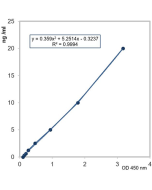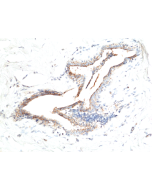Cookie Policy: This site uses cookies to improve your experience. You can find out more about our use of cookies in our Privacy Policy. By continuing to browse this site you agree to our use of cookies.
AdipoGen Life Sciences
Asprosin (human) (rec.) (His)
Replaces AG-40B-0174T

| Product Details | |
|---|---|
| Synonyms | Fibrillin-1 C-terminal Cleavage Product; FBN1 C Terminal Cleavage Product |
| Product Type | Protein |
| Properties | |
| Source/Host | E. coli |
| Sequence |
Human asprosin (aa 2732-2871) is fused at the C-terminus to a His-tag. |
| Crossreactivity | Human |
| MW | ~18kDa (SDS-PAGE) |
| Purity | ≥95% (SDS-PAGE) |
| Endotoxin Content | <0.01EU/μg purified protein (LAL test). |
| Concentration |
After reconstitution: for 10µg size: 0.1mg/ml for 100µg size: 1 mg/ml |
| Reconstitution | Reconstitute with 100μl sterile water. |
| Accession Number | P35555 |
| Formulation | Lyophilized from 0.2µm-filtered solution in 50mM Tris-HCl (pH8.2), 200mM NaCl. |
| Other Product Data |
Uni-Prot link P35555: Asprosin (human) |
| Shipping and Handling | |
| Shipping | BLUE ICE |
| Short Term Storage | +4°C |
| Long Term Storage | -20°C |
| Handling Advice |
After reconstitution, prepare aliquots and store at -20°C. Avoid freeze/thaw cycles. Centrifuge lyophilized vial before opening and reconstitution. |
| Use/Stability |
Stable for at least 6 months after receipt when stored at -20°C. Working aliquots are stable for up to 3 months when stored at -20°C. |
| Documents | |
| MSDS |
 Download PDF Download PDF |
| Product Specification Sheet | |
| Datasheet |
 Download PDF Download PDF |
Asprosin is a new fasting-induced protein hormone that targets the liver to increase plasma glucose levels. Asprosin is the C-terminal cleavage product of the protein pro-Fibrillin-1. Asprosin is secreted from white adipose tissue and increases hepatic glucose production by using cAMP as a second messenger, leading to activation of protein Kinase A. Reduction of Asprosin levels protects against metabolic syndrome-associated hyperinsulinism. Asprosin may act as a circulating hunger signal. Indeed, peripherally injected recombinant asprosin can cross the blood-brain barrier and intracerebroventricular (i.c.v.) injection of recombinant asprosin stimulated appetite in wild-type mice, indicating a central mechanism of action. Loss of Asprosin in mice and human leads to decreased fat mass and body weight, and hypophagia. Mice are also completely protected from the development of diet-induced obesity. Asprosin works by stimulating the orexigenic AgRP+ (Agouti related neuropeptide) neurons via a cAMP-dependent pathway and by inhibiting the anorexigenic neurons POMC+ (pro-opiomelanocortin) neurons in a GABA-dependent manner. Mutation in Asprosin in human leads to the pattern of metabolic dysregulation, including partial lipodystrophy, accompanied by reduced plasma insulin. Due to its key role in food regulation, Asprosin function could serve as a potentially unique therapeutic target against obesity, diabetes or metabolic diseases. Endogenous asprosin runs on SDS-PAGE at ~30kDa, while bacterially expressed recombinant asprosin runs at 18kDa. The difference of migration is probably due to predicted three N-linked glycosylation sites and potentially other post-translational modifications that are lacking in bacteria. Bacterially expressed recombinant asprosin retains the biological activity displayed by its endogenously expressed counterpart.








